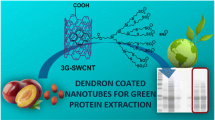Abstract
This paper’s proposal was to study the pH influence on protein exclusion in restricted access carbon nanotubes (RACNT), obtained by chemical modification of carbon nanotubes (CNT) using concentrated acid oxidizing agent (HNO3—65 % v/v). Oxidized CNT were coated with a layer of bovine serum albumin (BSA), resulting in RACNT–BSA. The isoelectric points of CNT, oxidized CNT, RACNT–BSA, BSA, and cross-linked BSA were determined by potentiometric titration. Percolating the BSA solutions at a concentration of 3 μg mL−1, in a phosphate buffer at a pH range from 2.2 to 7.0, by RACNT–BSA inside SPE cartridges, we studied the interactions among them. Solubilized BSA adsorbed in the RACNT–BSA surface at a pH range near the Ip (3.5–5.2), while in the other studied pH ranges this did not occur, which is mainly governed by electrostatic phenomena.




Similar content being viewed by others
References
Iijima S (1991) Helical microtubules of graphitic carbon. Nature 354:56–58. doi:10.1038/354056a0
Terrones M (2003) Science and technology of the twenty-first century: synthesis, properties, and applications of carbon nanotubes. Annu Rev Mater Res 33:419–501. doi:10.1146/annurev.matsci.33.012802.100255
Porter AE, Gass M, Bendall JS, Muller K, Goode A, Skepper JN, Midgley PA, Welland M (2009) Uptake of noncytotoxic acid-treated single-walled carbon nanotubes into the cytoplasm of human macrophage cells. ACS Nano 3:1485–1492. doi:10.1021/nn900416z
Vijayaraj M, Gadiou R, Anselme K, Ghimbeu C, Vix-Guterl C, Orikasa H, Kyotani T, Ittisanronnachai S (2010) The influence of surface chemistry and pore size on the adsorption of proteins on nanostructured carbon materials. Adv Funct Mater 20:2489–2499. doi:10.1002/adfm.201000288
Bohak Z (1977) Biotechnological applications of proteins and enzymes. Academic Press, New York
Dukovic G, Balaz M, Doak P, Berova ND, Zheng M, Mclean RS, Brus LE (2006) Racemic single-walled carbon nanotubes exhibit circular dichroism when wrapped with DNA. J Am Chem Soc 128:9004–9005. doi:10.1021/ja062095w
Ge C, Du J, Zhao L, Wang L, Liu Y, Li D, Yang Y, Zhou R, Zhao Y, Chai Z (2011) Binding of blood proteins to carbon nanotubes reduces cytotoxicity. Proc Natl Acad Sci USA 108:16968–16973. doi:10.1073/pnas.1105270108
Sun Y-P, Fu K, Lin Y, Huang W (2002) Functionalized carbon nanotubes: properties and applications. Acc Chem Res 35:1096–1104. doi:10.1021/ar010160v
Morikawa M, Kuboki Y, Akasaka T, Abe S, Watari F (2012) Effect of pretreatments to carbon nanotubes on protein adsorption. Nano Biomed 4:35–41. doi:10.11344/nano.4.35
Takada T, Kurosaki R, Konno Y, Abe S (2014) Interaction of multi-walled carbon nanotubes with water-soluble proteins: effect of sidewall carboxylation. J Nanosci Nanotechnol 14:3216–3220
Ahmad B, Ahmed MZ, Haq SK, Khan RH (2005) Guanidine hydrochloride denaturation of human serum albumin originates by local unfolding of some stable loops in domain III. Biochim Biophys Acta 1750:93–102. doi:10.1016/j.bbapap.2005.04.001
Guan Y, Zhang H, Wang Y (2014) New insight into the binding interaction of hydroxylated carbon nanotubes with bovine serum albumin. Spectrochim Acta A 124:556–563. doi:10.1016/j.saa.2014.01.058
Barbosa AF, Barbosa VM, Bettini J, Luccas PO, Figueiredo EC (2015) Restricted access carbon nanotubes for direct extraction of cadmium from human serum samples followed by atomic absorption spectrometry analysis. Talanta 131:213–220. doi:10.1016/j.talanta.2014.07.051
Jia Z, Wang Z, Liang J, Wei B, Wu D (1999) Production of short multi-walled carbon nanotubes. Carbon 37:903–906. doi:10.1016/S0008-6223(98)00229-2
Edri E, Regev O (2008) pH effects on BSA-dispersed carbon nanotubes studied by spectroscopy-enhanced composition evaluation techniques. Anal Chem 80:4049–4054. doi:10.1021/ac800124x
Marion MB (1976) A rapid and sensitive method for the quantitation of microgram quantities of protein utilizing the principle of protein-dye binding. Anal Biochem 72:248–254. doi:10.1016/0003-2697(76)90527-3
Cecchi HM (1999) Fundamentos teóricos e práticos em análise de alimentos. Editora da Unicamp, São Paulo
Jones DB (1941) Factors for converting percentages of nitrogen in foods and feeds into percentages of proteins. US Department of Agriculture, Washington DC
Peters T Jr (1995) All about albumin: biochemistry, genetics, and medical applications. Academic Press, San Diego
Masini JC (1993) Evaluation of neglecting electrostatic interactions on the determination and characterization of the ionizable sites in humic substances. Anal Chim Acta 283:803–810. doi:10.1016/0003-2670(93)85295-U
Soldatov V, Sosinovich Z, Korshunova T, Mironova T (2004) Acid–base properties of ion exchangers. I. Optimising of potentiometric titration of ion exchangers exemplified by carboxylic acid resins. React Funct Polym 58:3–12. doi:10.1016/j.reactfunctpolym.2003.11.003
Mesquita JPd, Martelli PB, Gorgulho HdF (2006) Characterization of copper adsorption on oxidized activated carbon. J Braz Chem Soc 17:1133–1143. doi:10.1590/S0103-50532006000600010
Kim UJ, Furtado CA, Liu X, Chen G, Eklund PC (2005) Raman and IR spectroscopy of chemically processed single-walled carbon nanotubes. J Am Chem Soc 127:15437–15445. doi:10.1021/ja052951o
Ortega F, Pandolfelli V, Rodrigues J, Souza DD (1997) Aspectos da reologia e da estabilidade de suspensões cerâmicas Parte I: fundamentos. Cerâmica 43:5–10. doi:10.1590/S0366-69131997000300003
Acknowledgements
We would like to acknowledge FAPEMIG, CAPES, and CNPq for the financial support.
Author information
Authors and Affiliations
Corresponding author
Ethics declarations
Conflict of interest
We wish to confirm that there are no known conflicts of interest associated with this publication and there has been no significant financial support for this work that could have influenced its outcome.
Intellectual property
We confirm that we have given due consideration to the protection of intellectual property associated with this work and that there are no impediments to publication, including the timing of publication, with respect to intellectual property. In so doing, we confirm that we have followed the regulations of our institutions concerning intellectual property.
Animal rights
We further confirm that any aspect of the work covered in this manuscript that has involved experimental animals has been conducted with the ethical approval of all relevant bodies and that such approvals are acknowledged within the manuscript.
Rights and permissions
About this article
Cite this article
Gomes, R.A.B., Luccas, P.O., de Magalhães, C.S. et al. Evaluation of the pH influence on protein exclusion by restricted access carbon nanotubes coated with bovine serum albumin. J Mater Sci 51, 7407–7414 (2016). https://doi.org/10.1007/s10853-016-9984-6
Received:
Accepted:
Published:
Issue Date:
DOI: https://doi.org/10.1007/s10853-016-9984-6




